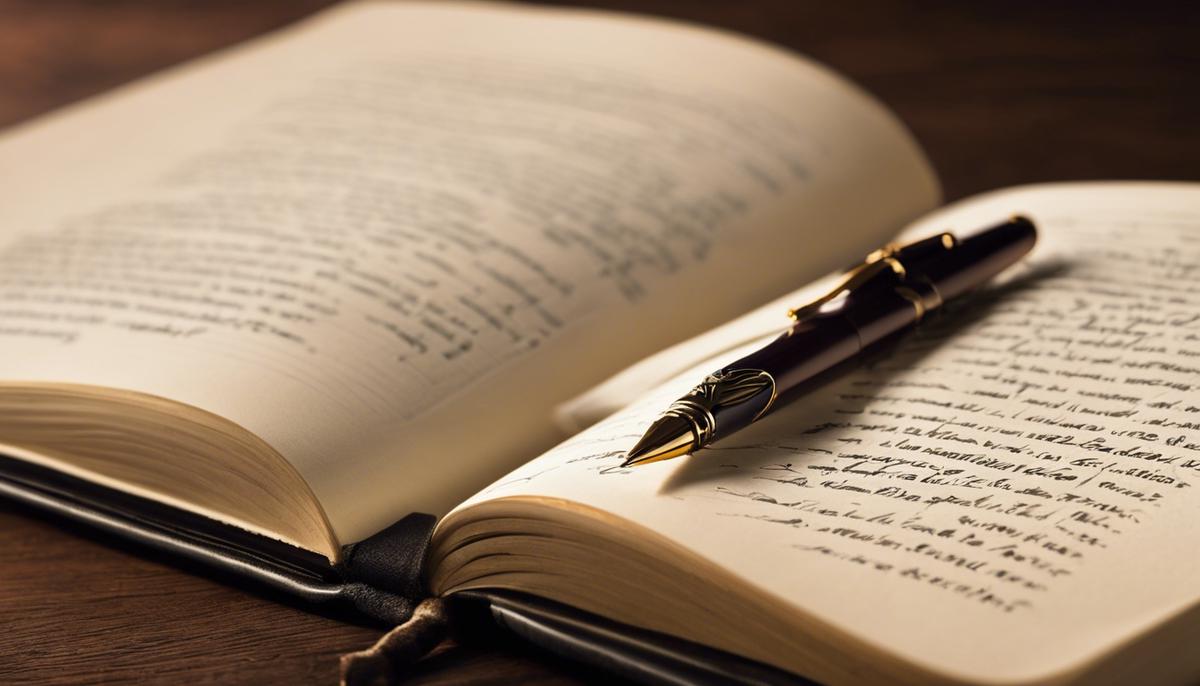Delving into the world of poetry is a journey of discovery and creativity. As potential artisans of this ancient form of expression, we explore not only the structural elements of poetry such as rhythm, rhyme, and meter, but also the various types it encompasses, including sonnets, haikus, limericks, and free verse. The path through this medium is also brimful with the unearthing of inspiration and theme—an essential task for any budding poet. The most evocative, touching, or poignant verses are often born from the depths of personal experiences, emotions, or imaginative flights of fancy.
Poetry basics
Restructuring Thought, Phrase, and Emotion: Pivotal Elements in Poetry Crafting
Capturing the world’s ebbs and flows in a fractional space, poems build bridges between the tangible and the ethereal, the unspoken and the objects of our reality. In the arena of this intuitive language of the soul, certain elements hold the keys to transforming words into poetry.
Firstly, a successful poem thrives on the delicate balance of structure and creativity. It could be a rigid sonnet or a free verse; regardless, structure serves as a skeleton to frame and direct artistic expression. On one hand, sticking to traditional poetic forms like haikus, limericks, or soliloquies reinforce cadence and rhythm, while on the other hand, breaking away from these molds ushers in exploration and innovation, giving rise to new poetic forms and interpretations.
Secondly, the manipulation of language to evoke emotion and provoke thought reigns supreme in poem crafting. This includes choosing the right words, employing varying sentence structures, and infusing a variety of literary devices. Metaphors, similes, and personification help in enriching descriptive language, thereby breathing life into seemingly mundane subjects.
Additionally, imagery is the lifeblood of poetry, creating a vivid and sensory experience for the reader. It assists in extracting the abstract into the concrete, making your poem a wellspring of resonating emotions. Smells, touches, sounds, sights, and tastes all play a role in the orchestration of a potent piece, instilling lasting impressions long after the last line is read.
Sound patterning, too, holds immense influence in verse crafting. Alliteration, consonance, assonance, onomatopoeia, and other phonetic resonances deepen the impact of the poem, enchanting readers with a lyrical charm. They also control the dimensions of rhythm and melody, infusing the poem with beats that either waft gently or echo assertively depending on the creator’s intent.
Moreover, effective verse composition operates in duality, bearing substance in the form of theme or message underpinning the motion of the words. From exploring societal issues to documenting personal narratives, poems serve as mirrors, reflecting and reframing perspectives. Therefore, it is crucial that your theme or message is cogent and relatable enough to strike a chord with your audience.
Lastly, notwithstanding the constraining bars of structure and language, the poem should freely speak the poet’s authentic voice. Reflecting the soul of the writer, giving a glimpse to their world, sharing their emotions, making us feel less alone in our thoughts and emotions – therein lies the power of poetry.
As someone once said, “Poetry is when an emotion has found its thought and the thought has found words.” In the vast pretense of poetry, each element not just enhances, but defines the verse. It captures the heartbeats between the now and the eternity, the essence of the visible and the understanding of the obscure, and distills life into a potent concoction of tangible abstraction.

Photo by florianklauer on Unsplash
Finding Inspiration & Theme
Acquainting with the Mechanics of Inspiration
To craft a perfectly resonant and rhythmically exquisite poem, understanding the mechanics of inspiration is a key catalyst. It’s about exploring submerged realms of thoughts, amid insights brewed in the kettle of a myriad experiences.
Drawing Concepts from the Ambient World
In the orchestra of life, the most commonplace occurrences often hide paramount tales. Be it in the hustle of a crowded marketplace or the tranquility of a historic library, inspiration lurks everywhere. Keen observation is the fuel that sparks the poetic fire. This could translate to prowess in showing rather than telling, enabling readers to experience the essence of your poem themselves.
Learn from Pioneers
Absorbing and understanding the work of celebrated poets across differing timelines can boost the poetic tenor in your compositions. Irrespective of the genre, the allure in their poems lies in the beauty of their language and their unique emotional resonance. Immerse in their verses, but remember, one must not draw too heavily and lose one’s creative independence.
Plunging into the Ocean of Emotion
The emotional landscape is the canvas of poetic composition. Harness personal experiences, excavate deep-seated feelings, or nestle in the thickets of wild imaginations. Poetic pursuits are powered by profound emotions. Embrace them, befriend them, grow with them – the most stirring verses are those dipped in the ink of authentic emotion.
Journaling Thoughts and Ideas
Ink down the fragments of fleeting thoughts, striking ideas, or interesting conversations. A line, a phrase, or even a single word can become the seed for a full-blown poem. Continuous collection of such snippets will eventually become a treasure trove of ideas, ensuring the muse never stays astray.
Embracing Silence and Contemplation
In an era of constant noise, inspiration often hides in the embrace of silence. Allow space for thoughtful contemplation, let ideas percolate, insights evolve, leading to a rich brew of profound themes and captivating perspectives in your poetry.
Harnessing the Art of Visualization
Transform abstract thoughts into vivid images. Practice visualizing scenes, emotions, or concepts, and let the words naturally spill out. The vividness of imagery roots the reader into the soul of the poem, providing a multi-sensory engagement and intensifying the emotional texture of the written verse.
In the quest to compose a compelling poem, know that every poet dances to a unique beat. May your journey in finding inspiration lead you to compose verses that not only move minds but awaken souls, critically engaging in the art of language while daringly showcasing emotional vulnerabilities.

Drafting and Revising Poems
Now that we’ve looked at the structure, language, and ideation of poetry, it’s time to expand upon the ways of enhancing the craft with further strategies. One of those ways includes drafting and revising poems for a heightened reader impact.
Step into the Process of Drafting.
A poem is like a beautiful building – it would be impossible without a solid draft or a blueprint. This stage involves free writing, where the initial ideas are jotted down without worrying about formatting or coherence. Note down every thought, preferably with pen and paper to allow for a free flow of ideas.
Some might assert that there is an equating factor between the spontaneous overflow of powerful feelings and poetry. However, as an entrepreneur carefully strategizes business plans, a poet meticulously crafts verses. Therefore, it is crucial not to restrict one’s thoughts during this stage. This phase is about creating a raw material reservoir from which one can construct the final product.
Hone the Skill of Revising.
Just like in business, where continuous quality checks are vital for the success of a product or service, revising poems is imperative for their overall impact. A poem, much like a premium service, is expected to deliver an enriching experience to its audience.
Effective revision includes examining each line and questioning its purpose. A poet’s main goal should be to ensure that each word and phrase adds something necessary and enriching to the entire piece. Pay attention to word choice and sentence structure, while also considering the rhythm and pace. It’s akin to a business operation’s efficiency check, where no step, however small, is overlooked.
Furthermore, consider the poem’s overall narrative. In the same way that business leaders review their strategic goals, poets must hone in on their poetry’s theme or message. Is the message clear? Does the poem provide sufficient evidence to support this theme?
Tailor Your Poem for Your Market.
To achieve maximum impact, the poem, like a professional service, should be tailored to its market. Consider who your audience is, and revise your poem with them in mind. Read it from their perspective – does the poem connect with the audience on an emotional level? Does it provoke thought? Language, theming, and imagery should all be adjusted to align with your target market’s preferences.
Remember, like every successful product or service, a poem is not about the creator but the consumer – the reader. Therefore, drafting and revising a poem’s verses is like refining a product to cater to market demands. It is your opportunity to make those word investments count, creating a robust product that fulfills consumer needs effectively.
In the end, a well-crafted poem, like an innovative product or service, delivers an experience that is unique, engaging, and impactful, whether it’s to a broad market audience or a niche group. Be open and receptive to revising your work; it’s just another stop on this exhilarating entrepreneurial journey of poetry.

Writing, by nature, is a process of constant refinement, and poetry is no exception. The journey doesn’t simply end once a draft poem has been completed. In fact, that’s often where the real challenge begins—drafting, revising, proofreading, and editing are steps of paramount importance in the creation of a finished piece. The beauty of poetry lies in its capacity to guide its creator through this intricate course, ensuring the essence and creativity of their work are not lost, but rather enhanced in the process. This exploration into the invaluable training programs for content writers is all about nurturing the poet in you, holding it up to the light, and watching it glitter…






